-
Paper Information
- Previous Paper
- Paper Submission
-
Journal Information
- About This Journal
- Editorial Board
- Current Issue
- Archive
- Author Guidelines
- Contact Us
Nanoscience and Nanotechnology
p-ISSN: 2163-257X e-ISSN: 2163-2588
2016; 6(1): 11-16
doi:10.5923/j.nn.20160601.03

RVE Analysis of Light Weight Carbon Nanotubes Embedded Piezoelectric Fibre Composites
V. K. Srivastava1, H. Berger2, U. Gabbert2
1Department of Mechanical Engineering, Indian Institute of Technology (BHU), Varanasi, India
2Institute of Mechanics, Faculty of Machine Building, Otto-von-Guericke-University of Magdeburg, Magdeburg, Germany
Correspondence to: V. K. Srivastava, Department of Mechanical Engineering, Indian Institute of Technology (BHU), Varanasi, India.
| Email: |  |
Copyright © 2016 Scientific & Academic Publishing. All Rights Reserved.
This work is licensed under the Creative Commons Attribution International License (CC BY).
http://creativecommons.org/licenses/by/4.0/

The hybrid piezoelectric composite comprised of carbon nanotubes and piezoelectric fibres as reinforcements embedded in a polyvinylidenedifluoride (PVDF) matrix is investigated. Effective elastic and piezoelectric properties of hybrid piezoelectric composite have been determined by the representative volume element (RVE) based on the finite element method. The results show that effective elastic coefficients and dielectric piezoelectric coefficient increases with increasing the volume fraction whereas piezoelectric coefficients e13, e23 and e33 are equal due to transversaly isotropy and decreases with increasing volume fraction. However, piezoelectric coefficients e42 and e51increases with increasing of volume fraction.
Keywords: Carbon nanotubes, Polyvinylidene difluoride, Elastic properties, Homogenization method
Cite this paper: V. K. Srivastava, H. Berger, U. Gabbert, RVE Analysis of Light Weight Carbon Nanotubes Embedded Piezoelectric Fibre Composites, Nanoscience and Nanotechnology, Vol. 6 No. 1, 2016, pp. 11-16. doi: 10.5923/j.nn.20160601.03.
Article Outline
1. Introduction
- Piezoelectric composites, often, called piezocomposites, have been used as distributed actuators and sensors. Piezocomposites (PZCs), usually comprised of an epoxy reinforced with a monolithic piezoelectric material (PZT), provide a wide range of effective material properties not offered by existing PZTs, are anisotropic, and characterized by good conformability and strength. Even through their properties make them interesting, they are often limited, first by their weight, that can be a clear disadvantage for shape control and, as a consequence, by their high specific acoustic impedance, which reduces their acoustic matching with the external fluid domain. Bulk piezoelectric materials have several drawbacks, and hence composite materials are often a better technological solution in the case of many applications such as in ultrasonic transducers, medical imaging, sensors, actuators and damping. In recent years, composite piezoelectric materials have been developed by combining piezoceramics with passive non-piezoelectric polymers. Superior properties have been achieved with these composites by taking advantage of the most beneficial properties of each constituent and a great variety of structures have been made [1-3]. Recently, polymeric nanocomposites filled with such nanoparticles as carbon nanotubes (CNTs), nanoclays, and have nanofibres have attracted a large amount of attention to achieve more enhanced mechanical, thermal, and electrical properties than conventional composites [4-6]. Especially, CNT has outstanding elastic modulus and tensile strength over the other nanoparticles. Many experimental investigations on mechanical properties of the CNT filled nanocomposites have been carried out but more studies are needed to realize the potential of CNTs as reinforcement [7-9]. In order to obtain a composite structure with tunable properties ranging from stiffer structure to better damper, the quality of adhesion between nanotube and matrix needs to be manipulated. In this regard, the restriction effect of nanotube on the surrounding polymeric matrix plays an important role. Salehi et al [10] proposed a continuous radiation model for a nano-epoxy system with an interphase layer around a nanomaterial. They showed that as the distance of polymeric segment and nanomaterial increases, the restriction effect of nanomaterial on the segment decreases gradually. Therefore, the farther segments are to the nanomaterial, the less immobilization of segments is formed. Also, interfacial slip is activated at the nanotube-polymer interfaces by raising the temperature. Therefore, at higher temperature the molecule density in the interphase zone decreases due to thermal expansion effects. To make this concept more powerful in term of response time polyvinylidene fluoride (PVDF) matrix is more useful than the polymer matrix. On the other hand, PVDF is very flexible, exhibits good stability over time and does not depolarize when subjected to very high alternating electric field. In order to enhance the necessary properties of PVDF with other organic or inorganic blends was recently investigated. Moreover, PVDF elements appear to have certain advantages in comparison with their piezoceramic counterparts. At present, PVDF polymer is produced in the form of thin film of thickness ranging from 102 x 10-4 to 762 x 10-3 mm. Utilizing ferroelectric ceramic particles or metal particles as a dispersed phase in piezoelectric polymer matrix has its own merits but suffers some drawbacks such as no uniform poling or suffering fatigue or early failure under cycling as well as dispersion of large particles, originated from the immiscibility. However, PVDF-multi-walled carbon nanotube (MWCNT) composites showed that the elevation of piezoelectric β form crystal was increased with MWCNT amount when subjected to poling. Besides the stretching and poling in the PVDF films, addition of MWCNT enhanced the β phase content by acting as nucleating agent and then its piezoelectric property, too [11-14].In the present study, the effective piezoelectric properties of the CNT / PVDF nanocomposite embedded with piezoelectric composite is examined by using the representative volume element (RVE) homogenization method.
2. Piezoelectric Constitutive Equations
- The behavior of the piezoelectric medium is described by the following piezoelectric constitutive equations, which correlate stresses (T), strains (S), electric field (E), and electrical displacement (D) as given below [1];
 | (1) |
 is the elasticity matrix, k is the permittivity matrix, and
is the elasticity matrix, k is the permittivity matrix, and  is the piezoelectric strain coupling matrix.For a transversely isotropic piezoelectric solid, the stiffness matrix, the piezoelectric matrix and the dielectric matrix simplify so there remain in all 11 independent coefficients. In the case of aligned fibers made of a transversely isotropic piezoelectric solid (PZT), embedded in an isotropic polymer matrix, the resulting composite is a transversely isotropic piezoelectric material (crystal class 6 mm) for a hexagonal array and tetragonal (crystal class 4 mm) for a square array. Consequently, the constitutive equation (1) for the composite can be written as [1];
is the piezoelectric strain coupling matrix.For a transversely isotropic piezoelectric solid, the stiffness matrix, the piezoelectric matrix and the dielectric matrix simplify so there remain in all 11 independent coefficients. In the case of aligned fibers made of a transversely isotropic piezoelectric solid (PZT), embedded in an isotropic polymer matrix, the resulting composite is a transversely isotropic piezoelectric material (crystal class 6 mm) for a hexagonal array and tetragonal (crystal class 4 mm) for a square array. Consequently, the constitutive equation (1) for the composite can be written as [1];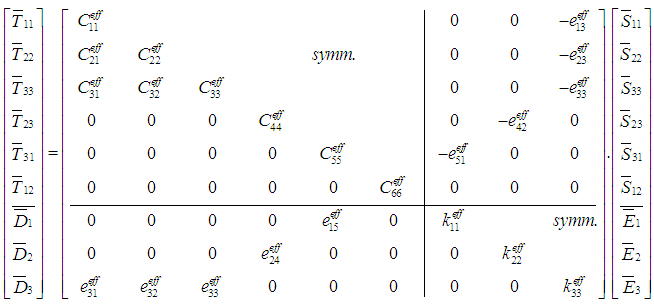 | (2) |
 for 6mm symmetry.
for 6mm symmetry.3. Results and Discussion
- Fig.1. schematically shows the procedure of homogenization technique used in this study.
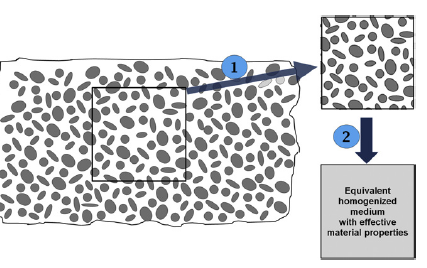 | Figure 1. Selection of modelling volume 1 and homogenization medium 2 |
|
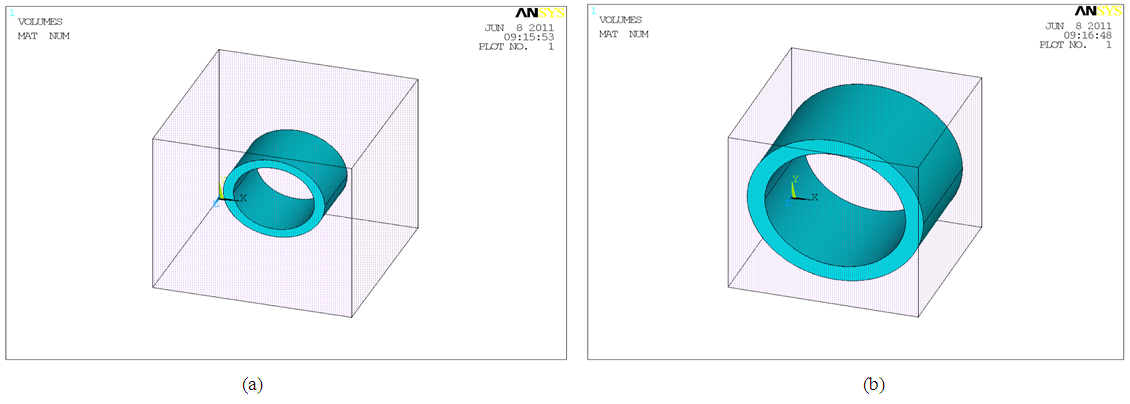 | Figure 2. Unit cell models (a) 2.5 % volume fraction and (b) 15 % volume fraction |
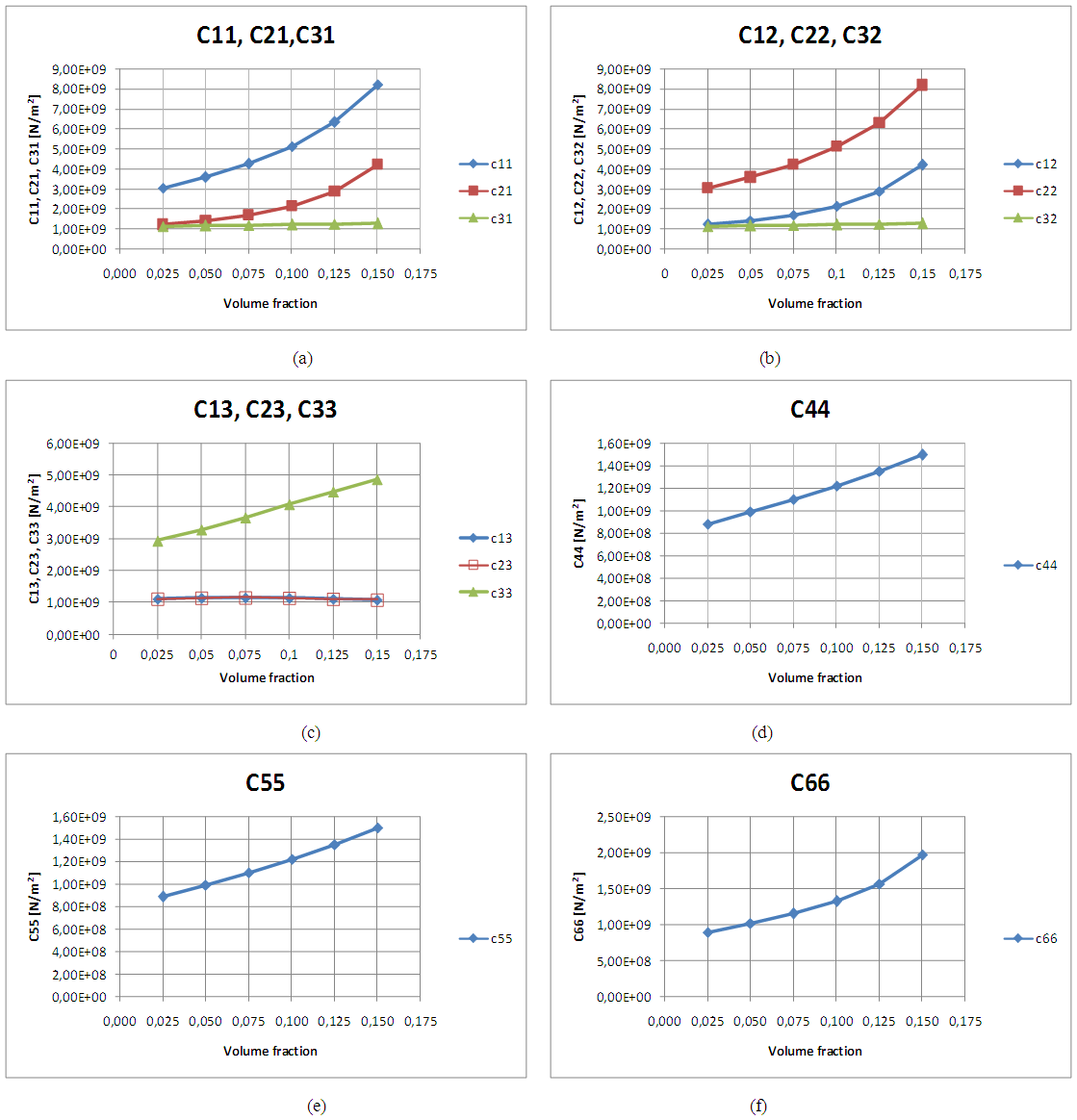 | Figure 3. Variation of effective elastic coefficients, (a) C11, C21, C31, (b) C12, C22, C32, (c) C13, C23, C33, (d) C44 (e) C55 and (f) C66 versus volume fraction |
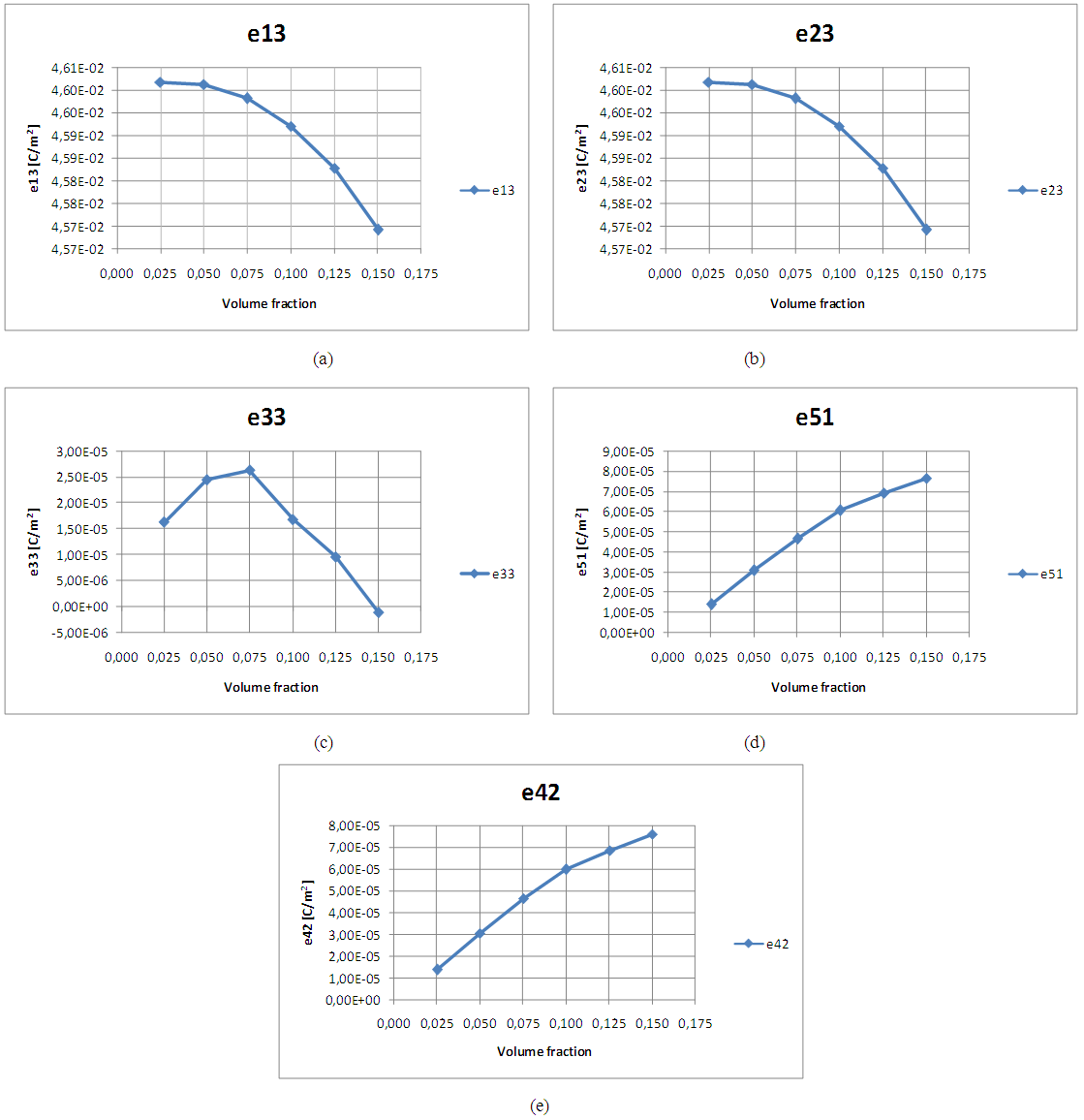 | Figure 4. Variation of effective piezoelectric coefficients, (a) e13, (b) e23, (c) e33, (d) e51 and (e) e42 versus volume fraction |
 | Figure 5. Variation of effective dielectric coefficients, (a) k11, (b) k22, and (c) k33 versus volume fraction |
4. Conclusions
- The investigations deal with calculations of effective material properties for a piezoelectric composite using a numerical homogenization technique with finite element method. Here especially carbon nanotubes are embedded in a piezoelectric matrix of PVDF. The results show the overall behavior of the composite for a regular arrangement of CNTs, aligned in one direction and square pattern. One main challenge in this investigation is find realistic material properties of the component. It has also been observed that the properties also depend on different parameters like frequency, volume of CNTs in the composites etc. Furthermore the dispersion of the nanotubes can be an important factor.
ACKNOWLEDGEMENTS
- The authors are thankful to DAAD, Germany and DST, New Delhi, India for the financial support under the bilateral International collaborative project.
 Abstract
Abstract Reference
Reference Full-Text PDF
Full-Text PDF Full-text HTML
Full-text HTML